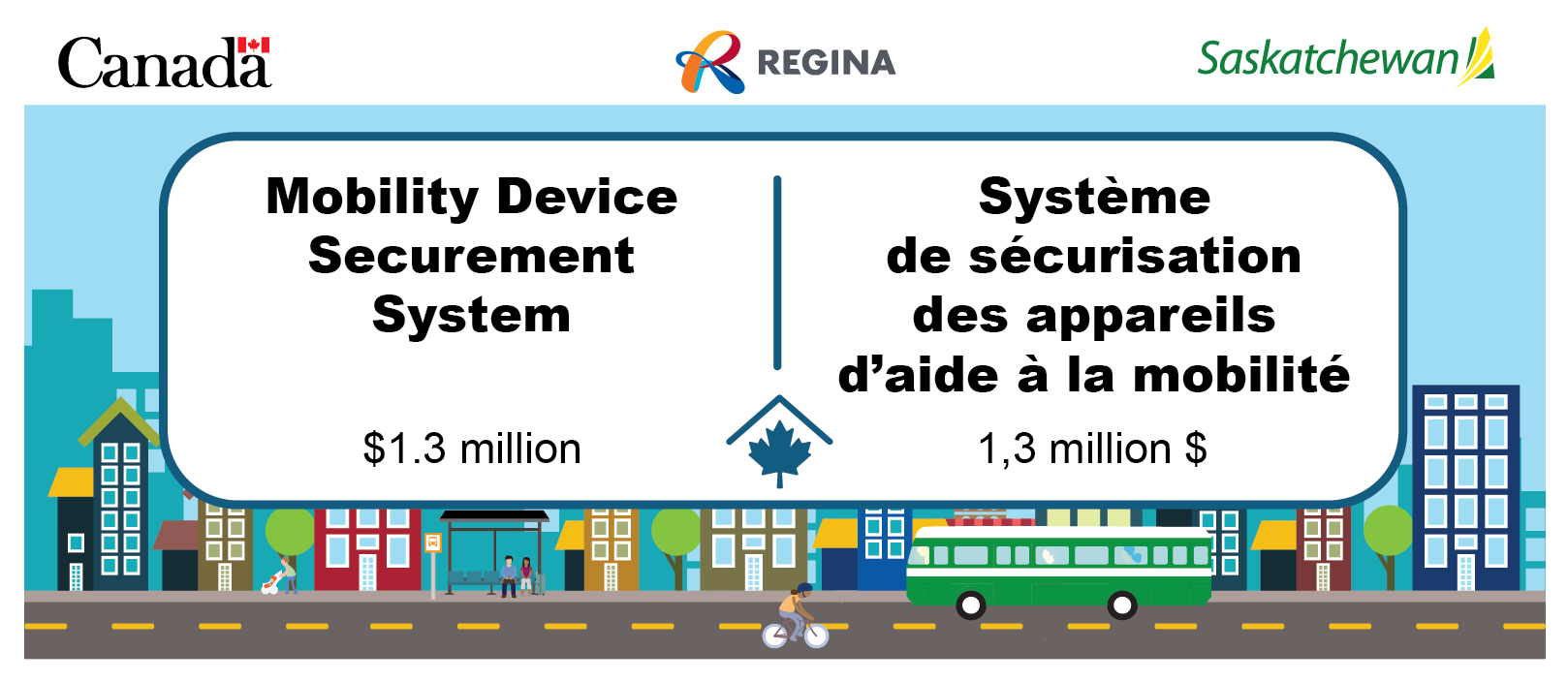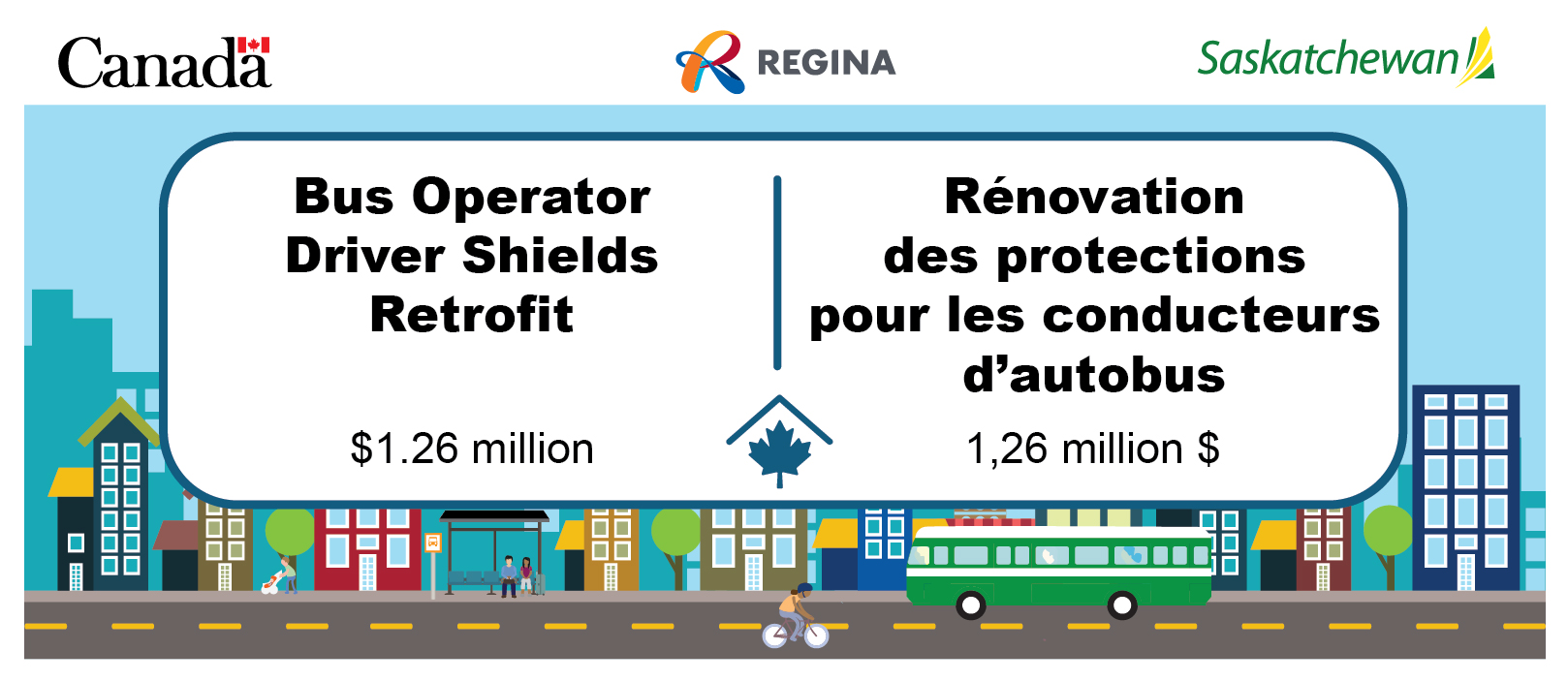Charter a Bus
Consider chartering a bus for your next group tour or special outing. Our professional, friendly drivers will take your group to any location in Regina or within a 25 km zone outside the city limits.
Charters are available for any time during the day and for any day of the week. Submit your request by calling 306-777-7000 or use the online contact us form at least five business days before your event.
Class Trips: Visit Book a Class Trip to learn more.
Bikes and E-scooters on Buses
Bikes: All Regina Transit buses are equipped with easy to use bike racks. The racks are mounted to the front of each bus and hold two bikes. Easy to follow instructions are printed on the rack.
Load: Let cyclists who are getting off the bus remove their bikes from the rack before loading your bike. To load your bike, follow these steps:
- Stand in front of the bike rack and squeeze the yellow handle to release the latch. Fold the bike rack down.
- Lift your bike onto the rack, fitting the wheels in the wheel trays. Note that the position of the front wheel is marked on the tray.
Pull the yellow support arm out and up over the top of the front tire to secure the bike in place.
Unload: About a block before your stop tell the bus operator that you want to get off at the next stop and that you will be unloading your bike. Exit the bus by the front door. To unload your bike, follow these steps:
- Pull the yellow support arm out and up over the tire to release it. Ensure the support arm clicks into place on the rack.
- Lift your bike out of the bike rack.
- Squeeze the yellow handle and fold the rack up into the locked position if the rack is empty and there is no one waiting to load their bike.
Move to the sidewalk and signal to the bus operator that it is okay for the bus to move out of the bus stop.
Note: Regina Transit is not responsible for damages incurred or caused by or to bicycles on Regina Transit property.
E-Scooters
Personal e-scooters are allowed on Regina Transit. Shared e-scooters from Bird and Neuron are not allowed on Regina Transit.
Animals on Buses
Regina Transit allows service animals to accompany customers on the bus. Passengers can also travel with their pets on transit and paratransit provided they are in a closed carrier. Other animals with documentation from a physician stating why the passenger requires to travel with an animal on transit and paratransit are also allowed on the bus.
Safe Bus
The Safe Bus program is a community partnership between the Regina Transit, Regina Crime Stoppers, and the Regina Police Service.
The Safe Bus program provides a safe space for anyone who needs help. If you are lost, hurt or in trouble, flag down a Regina Transit bus or get on at any bus stop.
Teach your children that if they are lost, cold, frightened or hurt, they can hold up their hand (palm facing out) in the direction of an approaching bus to signal the driver that they need help. Bus operators are trained to recognize this as a sign of distress and will stop to help your child. You can download Regina Transit’s Safe Bus Colouring and Activity Book to help explain the Safe Bus program to your child.
Trained transit personnel have direct access to 9-1-1 and you DO NOT need to pay a fare to get help through the Safe Bus program.
Night Stop
Our Night Stop program allows you to get off the bus between regular stops on your route, so you don’t have to walk as far to your destination.
To request the Night Stop service:
- Inform your driver that you wish to get off at a different location at least one bus stop before your regular stop. You don’t have to ring the bell.
- Remain near the front of the bus until the driver finds a safe place to open the door and let you off. In some instances, this may not be the exact spot you requested.
- Exit the bus from the front door.
Accessible Bus Stops
Regina Transit has six accessible bus stops located on 11th Avenue by the Cornwall Centre. These bus stops improve accessibility for customers with disabilities. The unique bus stops include:
- A yellow pole.
- A yellow schedule holder indicating the route name and numbers that stop at that location.
- A braille plaque indicating the route name and numbers stopping at that location.
- Raised lettering information plaque.
These unique features help persons with disabilities use and identify the bus stop. On 11th Avenue, we also have accessible heated bus shelters. Each shelter is powered by electricity and is large enough to accommodate a person using a mobility device. The light in the shelter comes on automatically when it becomes dark outside. Transit riders waiting for their bus can activate radiant heaters in the shelter by pushing a button. Also included is a braille "Push for heat" decal located beside the button. Once activated, the heat stays on for approximately five minutes.
Mobility Devices
The maximum size of mobility devices such as wheelchair or scooter that can be accommodated on a conventional bus is 34 inches wide by 51 inches long. Measurements must be taken at the broadest points of the mobility device to ensure it can fit on the bus.
Please note that some mobility devices, particularly four-wheeled scooters, might still have trouble getting on the bus. If a mobility device is unable to make the tight turn from the low floor ramp at the front door to the bus aisle towards the seating area, we recommend using paratransit services.
The City of Regina received funding under the new COVID-19 Resilience Stream of the Investing in Canada Infrastructure Program for Mobility Device Securement System to install 66 self-securement systems for mobility devices on 66 buses. These stations allow a hands-free approach for customers with mobility devices to secure themselves on the bus without the assistance of the operator.
 This project was funded in part by the Government of Canada and the Government of Saskatchewan. For more information on federal infrastructure funding, visit infrastructure.gc.ca.
This project was funded in part by the Government of Canada and the Government of Saskatchewan. For more information on federal infrastructure funding, visit infrastructure.gc.ca.
Driver Shields
The City of Regina received funding under the new COVID-19 Resilience Stream of the Investing in Canada Infrastructure Program for Bus Operator Driver Shields for retrofitting existing buses in the transit fleet to have permanent barriers in the operator compartment. Currently, all buses have a temporary barrier in place to help the spread of COVID 19. These new barriers will be a permanent hard structure to help protect operator and customer from virus spread, but also secures the operator from any physical threat as well.

This project was funded in part by the Government of Canada and the Government of Saskatchewan. For more information on federal infrastructure funding, visit infrastructure.gc.ca.
Lost and Found
All valuable articles left on Regina Transit are brought to the Transit Information Centre by the next working day. Call the Transit Information Centre at 306-777-7433 from 8:30 a.m. to 4:30 p.m. to see if your lost item was found on the bus. Please have the following information handy when reporting a lost item:
- Name.
- Phone number (day/evening).
- Date and approximate time the item was lost.
- Information about the bus or bus stop where the item was left (location of stop, bus route number/name).
- Description of the item (colour, size, type of material, model or serial number, or any other unique identifying marks).
Trip Tips
With so many passengers travelling on a bus, it’s important that everyone follow these tips to make sure every trip is pleasant and comfortable.
- Stay visible and never walk directly in front of or behind a bus.
- Warn children not to play near buses or bus stops. Serious injuries can occur if children throw rocks at buses or hang onto the back bumper of buses to “ski” down icy streets in winter.
- Have your fare, Umo Card, or transfer ready as the bus arrives.
- Obtain your transfer when paying your fare, not at the end of your trip.
- Board as quickly as possible and exit from the rear door of the bus.
- Leave designated priority seating available for seniors and those with limited mobility.
- Keep the aisle clear of bags, backpacks, and briefcases.
- Hold strollers securely or hold your child and fold the stroller during your trip.
- Use handrails if you must stand.
- Move to the back of the bus to allow additional passengers to stand.
- Do not put your feet on the seats or allow young children to stand on the seat.
- Do not smoke, litter, or cause a disturbance while riding the bus. Aggressive behaviour and coarse language will not be tolerated.
- Place carry-on bags, backpacks, and parcels under your seat or in your lap.
- Keep your arms and hands inside the bus.
Thanks for the Brake
The campaign encourages motorists to give buses a “brake” by slowing down to allow the bus to change lanes or merge into traffic more quickly when the bus has its left-signal light flashing.


